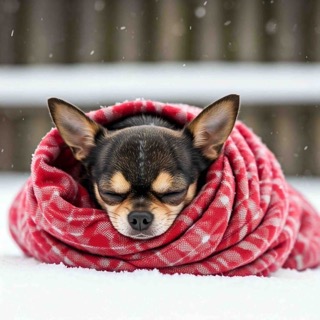
As the temperature drops and winter sets in, it's essential to take extra steps to ensure your pets stay warm and comfortable. Just like humans, pets can feel the chill, and prolonged exposure to cold weather can lead to health issues like hypothermia and frostbite. Whether your furry friend is a cat, dog, or small animal, here are some helpful tips to keep them cozy and safe during the winter months.
- Provide a Warm Sleeping Area
Pets need a warm, dry, and cozy place to sleep, especially during the cold winter nights. Make sure your pet’s bed is raised off cold floors, away from drafts, and placed in a room that is sufficiently heated. For extra warmth, consider providing blankets, heated pet beds, or self-warming mats that reflect your pet’s body heat. Small pets, such as cats or smaller dog breeds, are especially susceptible to cold and may appreciate a bed with high sides or a covered bed for extra insulation. - Limit Outdoor Time
During winter, limit your pet’s time outside, especially when the temperature drops below freezing. Dogs, in particular, may still need to go outside for walks and bathroom breaks, but keep these outings brief when it’s very cold. Frostbite can affect areas with less fur, such as the ears, paws, and tail, while hypothermia can be a real risk if pets are left outside too long. If your pet is an outdoor animal, like a barn cat or a dog that spends time outdoors, ensure they have a well-insulated shelter with plenty of dry bedding and protection from the wind. - Dress for the Weather
Not all pets have thick, winter-ready coats, so they might need some extra help staying warm outdoors. Short-haired dogs, small breeds, puppies, and older pets often benefit from wearing a sweater or coat when outside in cold weather. Make sure the clothing fits properly and covers their back, belly, and neck without restricting movement. It’s important to note that pets should not wear these items inside for long periods, as overheating can occur. - Protect Their Paws
Cold, snow, and ice can be harsh on a pet’s paws. Ice, in particular, can cause cracks or cuts, while the salt and chemicals used to melt snow can be toxic if licked off during grooming. To protect your pet’s paws, consider using pet-safe booties or applying paw wax before going outside. After each walk, wipe your pet’s paws with a damp cloth to remove any salt or ice that may have accumulated. Regularly trimming the fur between their paw pads can also prevent ice balls from forming. - Maintain Regular Exercise
Even though it’s cold outside, your pet still needs regular exercise to stay healthy and happy. If it's too chilly for long walks, try breaking them up into shorter, more frequent outings. For indoor pets, create fun activities inside to keep them engaged. Play with interactive toys, set up obstacle courses, or teach them new tricks to burn off excess energy. Cats can benefit from indoor play sessions with feather toys, laser pointers, or climbing trees to stay active. - Ensure Proper Nutrition
During the winter months, your pet might need a slight adjustment in their diet. Animals that spend more time outdoors or those that live in colder climates may require extra calories to help them maintain their body heat. On the other hand, indoor pets may become less active in the winter and require fewer calories to prevent weight gain. Consult with your veterinarian to ensure your pet is getting the right amount of food for their winter lifestyle. Also, ensure they have access to fresh, clean water, as dehydration can occur even in cold weather. - Monitor for Signs of Cold Stress
Pets can’t always communicate when they’re too cold, so it’s important to watch for signs of cold stress. Shivering, whining, lethargy, or seeking warmth near heat sources can all indicate that your pet is too cold. If you notice these symptoms, bring your pet inside immediately to warm them up. For dogs, keep an eye on their ears, tail, and paws for signs of frostbite, which may include discoloration or a cold, hard texture. - Use Caution with Heaters and Fireplaces
While space heaters and fireplaces can be great for warming up your home, they can also pose a danger to pets. Keep space heaters out of your pet’s reach to prevent burns or accidental tipping. If you have a fireplace, make sure it’s properly screened to protect curious pets from getting too close. Additionally, never leave pets alone in a room with a space heater or open fire. - Check Your Car for Hiding Pets
Cats, in particular, love to seek out warmth in the winter, and they may find your car’s engine or tires a cozy place to hide. Before starting your car in cold weather, give the hood a few taps to make sure no animals are sheltering inside. This simple precaution can help prevent serious injuries or even fatalities. - Be Mindful of Older Pets
Conclusion
Winter can be a challenging time for pets, but with a few simple precautions, you can ensure that your furry friend stays warm, healthy, and happy throughout the colder months. By providing a warm sleeping area, limiting outdoor exposure, dressing them appropriately, and being mindful of their needs, you can help your pet enjoy the winter season as much as possible. Remember, if you ever have concerns about your pet’s health during the winter, consult your veterinarian for guidance.
Staying cozy and comfortable in winter isn’t just for humans—your pet will appreciate the extra warmth and care!